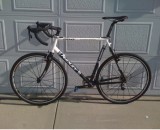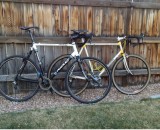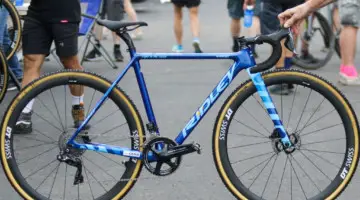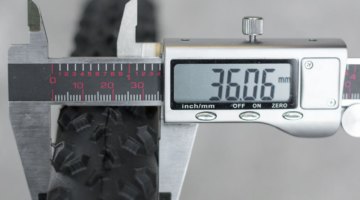Josh is our newest columnist, and he will be sharing his “noob” perspective with readers in weeks to come. Today, he’s introducing himself and giving us a little insight into life as a new racer. For more “Noob News,” check out our Training section for articles on barriers, videos on corners, training suggestions, and much more. To find out more about how Josh got into cyclocross in the first place, check out his first column. Today, he’s sharing his experiences with finding the right cyclocross bike for himself. It’s not an easy task when you’re 6’5″!
by Josh Schwiesow
How will I convince my wife to let me get a cyclocross bike?
When I started asking this question, I had five bikes. This wasn’t going to be an easy sell. Making it twice as difficult was the fact that she was kind of hoping to pick up a new road bike. Making it thrice as difficult was that I’d already gotten three new bikes in the whirlwind past year and a half or so.
In the first posting of this “noob” blog, I’d mentioned that I was a recent cancer survivor. However, I’d played the “cancer card” so many times I was pretty sure it wasn’t going to work again here – after all, I’d purchased two new bikes and my close riding buddies had actually made me a bike. You read that correctly, they made it, not purchased (incidentally, I hope none of you ever get a “cancer card” of your own, but if you do, I highly encourage you to play it often).
Here, I’ll divulge the next personal information tidbit about myself: it is worth mentioning that I stand 6’5” tall. So, buying any bike isn’t as easy as flipping through a catalog, magazine, or website and picking out what I like. It certainly involves all that, only the first step is checking size and geometry, rather than color, components and other fun stuff. Nearly all bike purchases involve creating something of an Excel spreadsheet detailing which manufacturers are even close on measurements, next listing their price and availability, and then making some phone calls. Sadly, it isn’t all about flipping through reviews. Typically, reviews come later in my purchase project, if at all.
I knew I wanted an aluminum frame. Why? My mountain bike skills aren’t fantastic, and I anticipated crashing. A lot. Hopefully softly, but crashing none-the-less (this happened, by the way, true story). Crashing made me nervous about carbon as a beginner. I also anticipated using this in adverse, mostly wet or snowy, conditions, which made me nervous about steel. Additionally, while one buddy suggested I wouldn’t want to carry the weight of steel, another suggested I wouldn’t notice given my size.
Many of you are unlikely to have noticed, but a wide variety of cyclocross bikes do not come in “size gigantor.” For example, one of the more popular bikes here locally is the Ridley X-Fire, with a maximum size of 58 cm. Luckily for me, that model was past my projected budget, and as noted above, I anticipated carbon to be a bad choice for a first ride. Still, not having the option limits you right out of the gate.
But wait … aren’t cyclocross bikes supposed to size down? How does this work? I asked a few friends, scoured the Internet forums, and called a few shops about this. The general consensus was to go with your normal size, and let the company get the geometry right. In other words, unless you’re right between sizes, go with what you usually would, thus taking those size 58s back out of the equation.
My first substantial cyclocross challenge would be finding a bike, mid-summer, when everyone else is shopping for cyclocross season. I had a few ideas and I called around to a few of my favorite local bike shops. Unfortunately, my options weren’t great. One option was a bike with disc brakes. I’d followed the sport enough to know the UCI had recently made disc brakes legal, but it felt so new that I wasn’t ready to be an early adopter before even knowing what I’d gotten myself into. Another option was steel, and as noted, I was concerned with weight and corrosion. Possibly unnecessarily, but I just didn’t know.
I finally had an idea narrowed down to an online source with a local outlet that could build it for me, but they couldn’t vouch for the fit. I had my spreadsheet, and it looked OK, but $1400 or $1500 was a lot for an educated guess. Playing the cancer card again, my wife was tentatively on-board.
I defaulted to my personal frame-builder. OK, I checked out the specs from the buddy of mine who happens to build frames as a hobby, and who made my bike. I like the “personal frame builder” bit better, but in truth, this is a guy who knows my needs far better than I know my own. I had stumbled upon Excel Sports’ website. They had a closeout sale on a 2010 Ridley Crossbow (now X-bow) in size 60. I ran the measurements to his file on my measurements. The match was good, and so I called the shop. Although it was slightly more expensive, my wife told me to buy what I “really wanted,” rather than bug her about it for the entire season. Much like my friends, she is also smarter than I.
It didn’t take long on the phone and I owned this bicycle. It was actually the first bike I’d ever ordered as a frame-only, and I loved Excel walking me through the build kit as if I were buying a nice, high-end bike, rather than some inexpensive close-out frame. I chose the SRAM Rival gruppo over the Ultegra, saving a few hundred dollars. The rest of the build was Ritchey components, including Aksium wheels and Speedmax clincher tires.
Coming in to actually be “fit” to the bike was also an extremely positive experience in that despite my spreadsheet, I still had some lingering doubt that it would work, but was very relieved to find out how comfortable the fit was. I was fit to the bike by an extremely knowledgeable staff, and our guesses on stems and seatposts were perfect.
No turning back now, I had a cyclocross bike.
One thing I immediately noticed was that the Ridley closely approximated my other bike’s fit, which was a relief. With my custom gift being the most comfortable bike I’ve ever ridden, I was excited that the Ridley was similar. Why not just ride the Brunner, given that it has “perfect gigantor geometry,” tons of room for fatter tires, and fits? When your friends make you a bike after being sick, and sign it on the paint, shipping it all over the country, you simply don’t ride it through grime and grit despite their encouragement to do so. At least I don’t. But yeah, it would work great … if not for what it means to me.
Here’s the Noob Hand-Up:
- There are a lot of great beginner bikes out there, but the best is the affordable one that fits.
- Carbon, Steel, Aluminum (and Titanium) are all great choices, but put some thought into what you need, especially as a noob.
- Making guesses on spreadsheets for fit must be verified by someone who knows what they are doing. Preferably someone who can check in person and understands your style.
- All things equal, support your local bike shop rather than internet source! A second and third pair of eyes are far better than pride and guessing wrong.






























